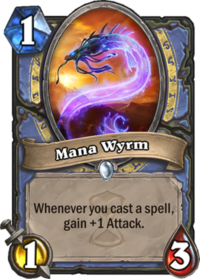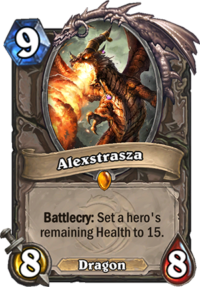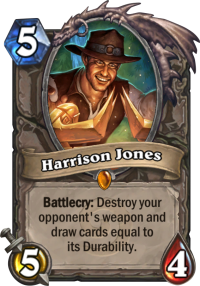Tempo is one of the (if not the) most important aspects in Hearthstone. Not only do many decks feed off of it, but there are quite a few archetypes built entirely around it. Tempo is a key part to pulling ahead of your opponent, getting efficient trades, and controlling the board. As a result, you are going to need to know how to properly utilize it if you want to play any aggro or midrange (and even some control) lists in this game.
Check out our full Hearthstone Beginner’s Guide to learn more!
Basic Tempo
Before we begin, it is important to define exactly what tempo is. The most basic definition is using pressure to control the game. For example, let’s say you play a turn one Mana Wyrm and your opponent counters with their turn two Crackling Razormaw. If you decide to trade your wyrm into the 3/2 and then ping it down with your hero power you are no longer in control of the tempo. Why? Because your opponent now has priority (also known as control) of the board. That means they can play what they want without having to react to you.

However, if you use a turn two Frostbolt to kill the razormaw, they then have to play into your 2/3 that’s left on the board. This might force them to them kill it with a turn three Eaglehorn Bow or Kill Command, which then gives you an empty board to play whatever you want. If you play another minion, your opponent then has to react to that, and the cycle continues.
The above example is one of the most basic forms of tempo. You play something, your opponent has to react, you play something else, they have to react, etc. However, it is not the only form of tempo. In fact, there are numerous types of tempo in Hearthstone, and understanding each of them is going to be a key part of winning games with any deck. In this guide we are going to look at those different forms and see how they all relate to both each other as well as the game as a whole.
Tempo in Hearthstone
Almost all the tempo in Hearthstone comes from minions. That is because minion pressure is the best way to force your opponent to make bad decisions or take poor lines of play. Think of tempo as pressure, where you use your board to threaten to kill your opponent. You have minions that do damage, and they need to react to those minions or they will lose.
This is the exact philosophy behind efficient aggro decks. They come out of the gates with a fast opening and quick damage, which then forces their opponent to spend the whole game trying to catch up to that early push. A good example of this is when a Pirate Warrior plays a turn three Frothing Berserker into a turn four Kor'kron Elite and turn five Arcanite Reaper. Without a taunt, that push is going to be at least sixteen damage. That means most decks need to spend resources or spells to take down those threats. While that may save damage upfront, spells do not impact the board, which allows Pirate to stay in control of the tempo.
Hyper-aggressive decks like Aggro Druid and Pirate Warrior are built off of that style type of tempo, where they expect their opponent to react to them. They use damage to make it so their opponent can never play a minion for fear of losing too much life. Running out a 4/4 is not going to do anything against a massive wall of minions. This is the reason cards like Medivh's Valet and Fire Elemental are so powerful. They both give you a removal spell and a body on the board at the same time.

However, it should be noted that, while aggressive tempo is the most common in the game, it is not restricted to aggressive decks. Every type of deck can make use of their damage, and knowing how and when to make that happen is an important aspect of Hearthstone. If you get out ahead of your opponent, or if you have a big board, it is often correct to pressure them by attacking face or making efficient trades. This will cause them to worry about their life total and keep them on their heels. You can take advantage of this move by running out a lot of minions on turn five against a Hunter before they play Savannah Highmane or on turn eight against Mage before Alexstrasza. In both of these situations, putting out a lot of bodies will threaten so much damage they will have to take other, less powerful, routes. This is tempo forcing your opponent off of their set gameplan.
Another large part of tempo is keeping your opponent’s board clear. Trading (running one minion into another) is a key aspect of Hearthstone because it helps you maintain tempo. This is a game where the person attacking is in control of the board, and that means you typically want to be the one attacking. Unless you are at a low life total, having the board means controlling the tempo. Aggro feeds off of this (as noted above) but midrange and tempo decks do as well. However, note that it is not all about pushing damage either.
A lot of the time, leveraging pressure is going to be about keeping your minions around while removing your opponent’s. Something as simple as trading a 3/4 into a 3/2 removes your opponent’s minion and gives you a 3/1 behind. While that may not be the scariest body, it then gives you something to push damage or control the board with. Always think about how to keep your minions alive, and then think about the best way to use those to push for future turns. Even having a 2/2 on the board can make your opponent use removal instead of playing a threat.
Finally, we are going to look at the subtlest type of tempo, which is tempo that you cannot see. As covered, most games you are going to attempt to get out ahead of your opponent on the board and then ride that leverage to victory in one way or another. However, there is also a type of tempo where you play minions that help you control a board state that does not yet exist. The classic example of this is dropping a Doomsayer onto an empty board. This play can seem strange (especially when someone does it during the middle of the game) but most people will not be able to remove the 0/7. That means it stops your opponent from playing minions for a turn and gives you the ability to set up your next threat on a clean slate. That is powerful and helps you push ahead when you need to fill in the curve.

This type of tempo is going to come up less than the first examples, but it is just as important. This style manifests in different ways, but another version is when you make sub-opportune plays just to get ahead on the board. It is very easy to hold back certain cards because of their ability. However, there are many times where you want to just play something for its stats. Harrison Jones might get you eventual value at some point in a game, but if it is turn five and your opponent is building up pressure you need to react. This comes up quite often (playing a turn three SI:7 Agent turn three against Druid without worrying about the combo) and you need to take this route to stay in a lot of games. Bodies give you stats. Stats give you pressure. Pressure gives you priority. Priority gives you board. Board gives you tempo. It really is that easy.

Great Article!
I like how you described that minions –> stats –> Tempo.
I find it unfortunate that Ungoro printed too many low cost good stat minions, and an abnormally large amount of minions (perhaps to fit the theme?!?), and they printed fewer spells. It makes the game very much dependent on exactly what you are describing.
There is definitely a lot of tempo right now, but I don’t think it’s necessarily Un’goro’s fault. In fact, I would say Un’goro has one of the slowest meta’s we’ve seen in some time. Tempo is always going to be there because of the fact that attackers have priority in Hearthstone. However, we are slowly moving away from the world of Tunnel Trogg and Undertaker. These things take time to shift. I took Control Priest to rank two last month, been a long time since I’ve been able to say that, haha.
Great guide. Pro Tip, unless your opponent draws horribly, if they’re playing freeze mage, or quest rogue, none of this matters.
Rogue is historically the class that probably most messes around with tempo; a lot of Rogue archetypes sacrifice early tempo for big combo swings. Not so much in Standard now (bar the Vilespine Slayer) but you still have to watch out in Wild.
Malygos Miracle Rogue was probably the ultimate case in point; they look like they’re just hanging on for most of the game but as soon as Emperor Thaurissan hits the board you know you’re probably dead next turn unless you’ve got more than 25 health (but even that’s not guaranteed to save you).
Great article. You explain tempo in a way that’s easy to understand.
Thanks! I think it’s important to explain the basics in that way.